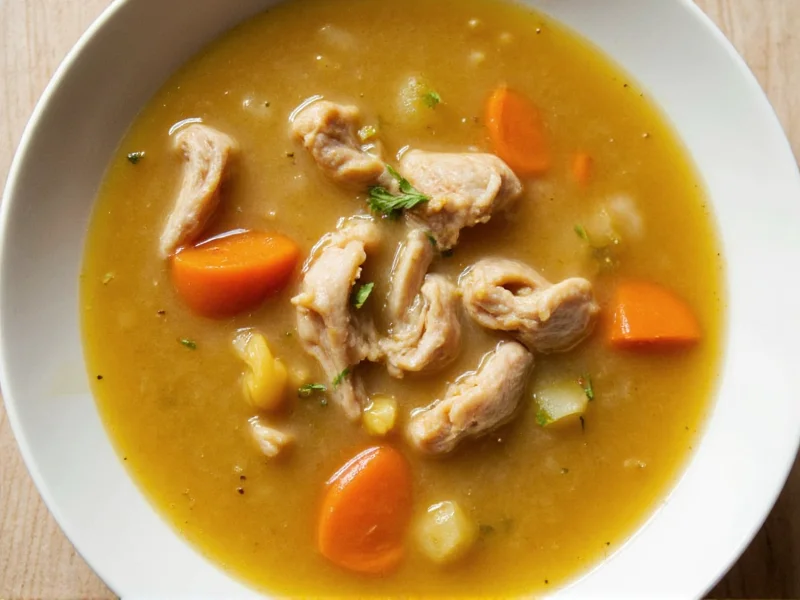Nothing beats a bowl of authentic chicken soup for comfort and nourishment. This foolproof recipe delivers rich flavor through proper technique—not shortcuts. The secret? Simmering bone-in chicken thighs (not just breasts) creates collagen-rich broth with superior body and depth. Unlike store-bought versions, our method develops complex flavors by sautéing vegetables before adding liquid and finishing with fresh herbs.
Essential Ingredients for Flavorful Chicken Soup
Quality ingredients make the difference between bland and brilliant soup. Measure precisely for balanced flavor:
| Ingredient | Quantity | Pro Tip |
|---|---|---|
| Bone-in, skin-on chicken thighs | 2 lbs (900g) | Provides richer broth than breast meat alone |
| Yellow onions, chopped | 1 large | Use yellow for best flavor foundation |
| Carrots, peeled and sliced | 3 medium | Cut uniformly for even cooking |
| Celery stalks with leaves | 3 stalks | Leaves add herbal notes |
| Fresh parsley | ¼ cup chopped | Add at end for bright flavor |
| Dried thyme | 1 tsp | Essential earthy note |
| Bay leaves | 2 | Remove before serving |
| Kosher salt | To taste | Season in layers for best results |
Step-by-Step Chicken Soup Preparation
Broth Development (45 minutes)
- Pat chicken dry and season with salt and pepper. In a 6-quart pot, heat 1 tbsp olive oil over medium-high heat. Brown chicken thoroughly (8-10 minutes), then remove.
- Add onions, carrots, and celery. Sauté until onions become translucent (5-7 minutes). Add garlic and cook 1 minute until fragrant.
- Return chicken to pot with 8 cups cold water, thyme, and bay leaves. Bring to gentle simmer (not boil).
- Skim foam that rises to surface during first 10 minutes. Reduce heat to low, cover, and simmer 35 minutes.
Finishing the Soup (20 minutes)
- Remove chicken, discard skin and bones. Shred meat into bite-sized pieces.
- Strain broth through fine-mesh sieve, pressing vegetables to extract liquid. Discard solids.
- Return broth to clean pot. Add shredded chicken and egg noodles (8 oz). Simmer 8-10 minutes until noodles are tender.
- Stir in parsley, lemon juice (1 tbsp), and additional salt to taste. Serve immediately.
Pro Techniques for Superior Chicken Soup
Achieve restaurant-quality results with these professional methods:
- Layered seasoning: Salt vegetables during sautéing, again when adding water, and finally at the end. This creates dimensional flavor.
- Temperature control: Maintain a gentle simmer (small bubbles barely breaking surface). Boiling makes broth cloudy and toughens chicken.
- Acid balance: Finish with lemon juice or apple cider vinegar to brighten rich flavors—never skip this step.
- Fat management: Chill broth overnight to easily remove solidified fat, or use a fat separator during cooking.
Variations for Different Dietary Needs
Adapt this classic chicken soup recipe for special requirements:
- Gluten-free: Use rice noodles or quinoa instead of egg noodles. Ensure broth is certified GF.
- Keto version: Omit noodles, add extra vegetables like zucchini noodles (add in last 5 minutes).
- Instant Pot method: Sauté veggies, add 6 cups water, chicken, and seasonings. Pressure cook 15 minutes, natural release 10 minutes.
- Freezer-friendly: Portion cooled soup into airtight containers, leaving 1-inch headspace. Keeps 3 months.
Common Mistakes to Avoid
Prevent these frequent errors when making homemade chicken soup:
- Boiling instead of simmering: Creates cloudy broth and tough meat. Keep temperature at 180-200°F (82-93°C).
- Overcooking vegetables: Add delicate veggies like peas or spinach in the last 5 minutes.
- Skipping the skimming step: Foam contains impurities that make broth taste metallic.
- Underseasoning: Broth needs more salt than you expect. Taste and adjust before serving.
Storage and Reheating Instructions
Proper storage maintains flavor and safety:
- Cool soup within 2 hours of cooking
- Refrigerate in airtight containers for up to 4 days
- Freeze without noodles for best texture (noodles become mushy when frozen)
- Reheat gently on stove—never boil reheated soup
- Add fresh herbs and a splash of lemon juice when reheating for best flavor
Frequently Asked Questions
Can I use chicken breast instead of thighs in this chicken soup recipe?
Yes, but use a combination of dark and white meat. Breasts alone create bland broth with less body. For best results, use 1 lb breasts and 1 lb thighs. Add breasts during the last 20 minutes of simmering to prevent overcooking.
How do I fix bland chicken soup?
Revive underseasoned soup by adding ¼ tsp each of salt and umami boosters like soy sauce or tomato paste. A splash of acid (lemon juice or vinegar) brightens flat flavors. Simmer 5 minutes after adjustments to allow flavors to meld.
Why does my chicken soup taste watery?
Watery broth usually results from insufficient simmering time or too much water. Reduce liquid by simmering uncovered for 15-20 minutes. Alternatively, make a slurry with 1 tbsp cornstarch and 2 tbsp cold water, then whisk into simmering soup until thickened.
What's the difference between chicken soup and chicken noodle soup?
Chicken soup refers to the broth-based soup with chicken and vegetables. Chicken noodle soup specifically includes egg noodles or other pasta. Authentic versions add noodles during the final cooking stage to prevent mushiness.
How can I make chicken soup without鸡汤 (chicken stock)?
You don't need store-bought stock. This recipe creates its own rich broth by simmering chicken bones and vegetables. For vegetarian version, use mushroom trimmings and kombu seaweed to create umami-rich vegetable broth as base.











 浙公网安备
33010002000092号
浙公网安备
33010002000092号 浙B2-20120091-4
浙B2-20120091-4